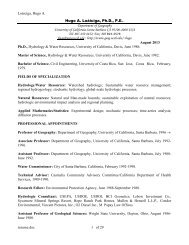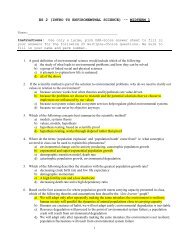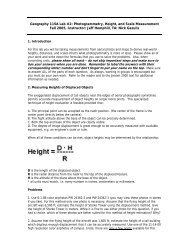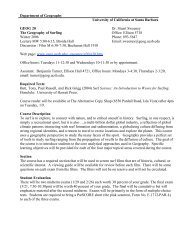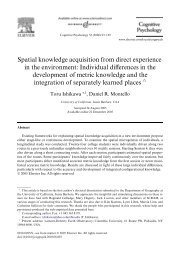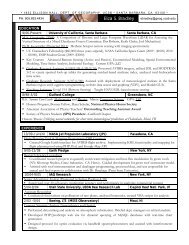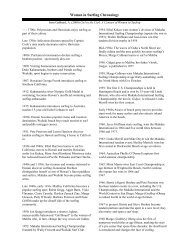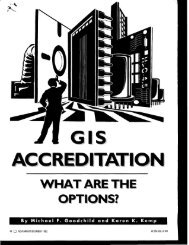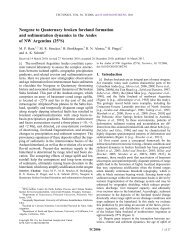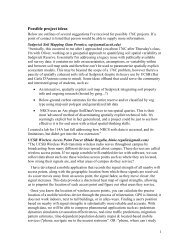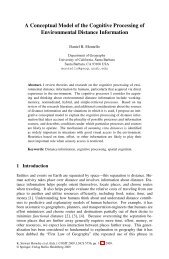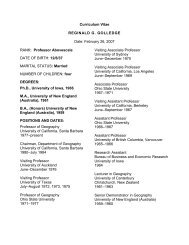Farm households and land use in a core conservation zone of the ...
Farm households and land use in a core conservation zone of the ...
Farm households and land use in a core conservation zone of the ...
You also want an ePaper? Increase the reach of your titles
YUMPU automatically turns print PDFs into web optimized ePapers that Google loves.
groups <strong>of</strong> ascend<strong>in</strong>g population density had roughly one caballeria <strong>of</strong> l<strong>and</strong> (give or take<br />
several hectares) while <strong>the</strong> majority <strong>of</strong> <strong>the</strong> farmers <strong>in</strong> <strong>the</strong> two groups <strong>of</strong> highest<br />
population density worked small rental subsistence plots <strong>of</strong> only several hectares.<br />
< Table 3 about here ><br />
As anticipated, a negative relation existed between ho<strong>use</strong>hold population density<br />
<strong>and</strong> total l<strong>and</strong> <strong>in</strong> forest <strong>and</strong> percentage <strong>of</strong> l<strong>and</strong>hold<strong>in</strong>gs <strong>in</strong> forest. Higher density<br />
<strong>ho<strong>use</strong>holds</strong> devoted virtually all <strong>the</strong>ir l<strong>and</strong> to crop production with little or no l<strong>and</strong> <strong>in</strong><br />
forest, fallow, or o<strong>the</strong>r l<strong>and</strong> <strong>use</strong>s. The difference between <strong>the</strong> percentage <strong>of</strong> <strong>the</strong> farm<br />
devoted to crops <strong>in</strong> <strong>the</strong> high density <strong>ho<strong>use</strong>holds</strong> relative to <strong>the</strong> low density <strong>ho<strong>use</strong>holds</strong><br />
was much greater than <strong>the</strong> difference <strong>in</strong> <strong>the</strong> absolute number <strong>of</strong> hectares <strong>in</strong> crops between<br />
<strong>the</strong> two groups. Indeed, <strong>of</strong> <strong>the</strong> forty <strong>ho<strong>use</strong>holds</strong> <strong>of</strong> highest density, only a fraction had<br />
any l<strong>and</strong> not <strong>in</strong> crops. This <strong>of</strong>fers tentative support for two important notions: (1) <strong>the</strong><br />
existence <strong>of</strong> a hierarchy <strong>of</strong> l<strong>and</strong> <strong>use</strong> needs, as follows: (a) short-term subsistence <strong>in</strong> <strong>the</strong><br />
form <strong>of</strong> crop production, (b) long-term ma<strong>in</strong>tenance <strong>of</strong> subsistence (fallow l<strong>and</strong>), <strong>and</strong>, (c)<br />
enhanced ho<strong>use</strong>hold security through asset diversification⎯<strong>and</strong> ultimately, capital<br />
accumulation⎯<strong>in</strong> <strong>the</strong> form <strong>of</strong> cattle <strong>and</strong> (2), <strong>the</strong> threshold <strong>of</strong> (short-term) subsistence for<br />
rudimentary, maize farm<strong>in</strong>g appeared to be 2–3 ha <strong>of</strong> l<strong>and</strong>.<br />
Although <strong>the</strong> measure <strong>of</strong> agricultural <strong>in</strong>tensification lacks a statistically<br />
significant association with population density, it is noteworthy that <strong>the</strong> groups <strong>of</strong> lowest<br />
<strong>and</strong> highest density were <strong>the</strong> least <strong>in</strong>tensive farmers, as measured by <strong>the</strong>ir <strong>use</strong> <strong>of</strong> <strong>the</strong><br />
nitrogen-fix<strong>in</strong>g legume, (velvet bean) <strong>and</strong> herbicides. High-density <strong>ho<strong>use</strong>holds</strong> farm<strong>in</strong>g<br />
only 2–3 ha cropped all <strong>of</strong> <strong>the</strong> l<strong>and</strong> for short-term subsistence despite hav<strong>in</strong>g to ab<strong>and</strong>on<br />
<strong>the</strong> plot follow<strong>in</strong>g two years <strong>of</strong> harvests due to decl<strong>in</strong><strong>in</strong>g soil fertility. These <strong>ho<strong>use</strong>holds</strong><br />
tended to rent l<strong>and</strong> <strong>in</strong> different places each year or two, <strong>in</strong> many cases serv<strong>in</strong>g as free<br />
labor for large farmers to clear forest <strong>and</strong> sow pasture <strong>in</strong> exchange for us<strong>in</strong>g <strong>the</strong> l<strong>and</strong> for<br />
two to four maize harvests. S<strong>in</strong>ce <strong>the</strong>y move to ano<strong>the</strong>r plot <strong>the</strong> follow<strong>in</strong>g year, <strong>the</strong>re is<br />
no <strong>in</strong>centive for <strong>the</strong>m to <strong>in</strong>vest <strong>in</strong> <strong>conservation</strong> techniques. The lowest density<br />
<strong>ho<strong>use</strong>holds</strong> also had little <strong>in</strong>centive to <strong>in</strong>tensify, but for quite different reasons. They were<br />
comprised <strong>of</strong> young <strong>ho<strong>use</strong>holds</strong> with little labor supply or consumption dem<strong>and</strong> on<br />
comfortably large farms. This underst<strong>and</strong><strong>in</strong>g <strong>of</strong> <strong>the</strong> local context helps expla<strong>in</strong> why<br />
population density relations to agricultural <strong>in</strong>tensification do not follow expectations<br />
from Boserupian <strong>the</strong>ory. It also unders<strong>core</strong>s <strong>the</strong> importance <strong>of</strong> closely exam<strong>in</strong><strong>in</strong>g data <strong>in</strong><br />
cross-tabular form before dismiss<strong>in</strong>g as mean<strong>in</strong>gless <strong>in</strong>significant variables <strong>in</strong> regression<br />
analyses.<br />
Socio-economic Factors<br />
<strong>Farm</strong> size<br />
By exam<strong>in</strong><strong>in</strong>g l<strong>and</strong> <strong>use</strong> by farm size, it is possible to <strong>in</strong>vestigate dist<strong>in</strong>ctions between<br />
population density <strong>and</strong> farm size effects on l<strong>and</strong> <strong>use</strong> outcomes (Table 4). <strong>Farm</strong> size was<br />
significantly related to all <strong>the</strong> variables clustered toge<strong>the</strong>r <strong>in</strong> model 1: duration on <strong>the</strong><br />
farm, expected hectares <strong>in</strong> crops <strong>and</strong> <strong>in</strong> pasture, l<strong>and</strong> tenure, <strong>and</strong> distance to a road.<br />
Moreover each <strong>of</strong> <strong>the</strong>se variables rema<strong>in</strong>ed significant when comb<strong>in</strong>ed with l<strong>and</strong> <strong>use</strong><br />
outcome variables. Insignificant were hectares <strong>in</strong> pasture <strong>and</strong> cattle adoption. However,<br />
when hectares <strong>of</strong> cattle anticipated <strong>in</strong> 2008 is removed from <strong>the</strong> model both <strong>the</strong>se<br />
12



